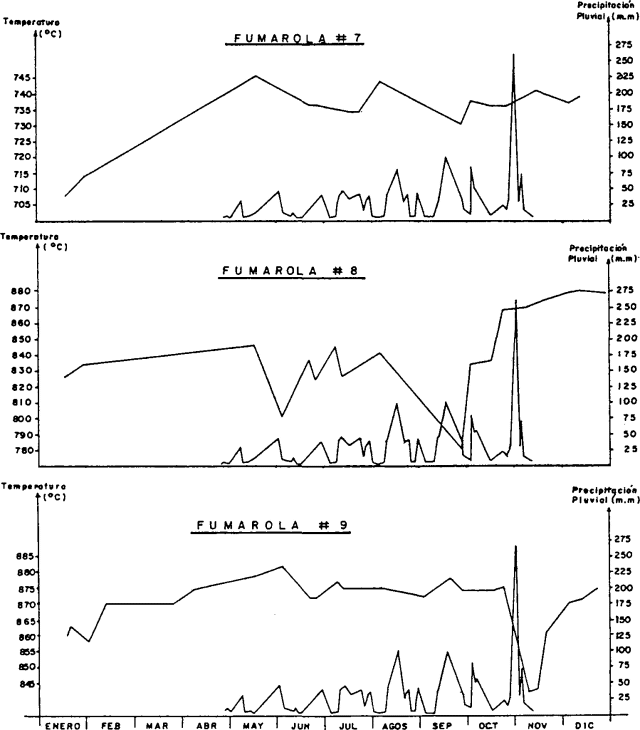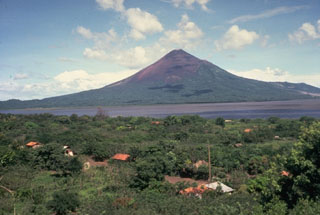Report on Momotombo (Nicaragua) — May 1986
Scientific Event Alert Network Bulletin, vol. 11, no. 5 (May 1986)
Managing Editor: Lindsay McClelland.
Momotombo (Nicaragua) Fumarole temperatures decline after heavy rains
Please cite this report as:
Global Volcanism Program, 1986. Report on Momotombo (Nicaragua) (McClelland, L., ed.). Scientific Event Alert Network Bulletin, 11:5. Smithsonian Institution. https://doi.org/10.5479/si.GVP.SEAN198605-344090
Momotombo
Nicaragua
12.423°N, 86.539°W; summit elev. 1270 m
All times are local (unless otherwise noted)
Heavy rains fell along the entire Pacific coast of Nicaragua from 30 October to 3 November 1985. Of the three highest-temperature fumaroles, the temperature of one (#9) dropped 33°C around the time of the heavy rains (figure 3), while temperatures of the other two continued to increase slightly. The temperature of fumarole ##9 had recovered by late December and continued to increase gradually through early April (table 3).
 |
Figure 3. Temperature and precipitation data at three of Momotombo's fumaroles, January-December 1985. Rainfall data are from Nagarote Station, the nearest to Momotombo. Courtesy of INETER. |
Table 3. Temperatures (°C) at Momotombo's fumarole #9, October 1985-April 1986. Courtesy of INETER.
| Date | Temperature (°C) |
| 29 Oct 1985 | 875 |
| 11 Nov 1985 | 842 |
| 14 Nov 1985 | 843 |
| 20 Nov 1985 | 861 |
| 04 Dec 1985 | 869 |
| 11 Dec 1985 | 871 |
| 27 Dec 1985 | 875 |
| 15 Jan 1986 | 875 |
| 27 Jan 1986 | 880 |
| 20 Feb 1986 | 880 |
| 27 Feb 1986 | 876 |
| 06 Mar 1986 | 875 |
| 15 Mar 1986 | 880 |
| 23 Mar 1986 | 882 |
| 04 Apr 1986 | 885 |
| 10 Apr 1986 | 885 |
Geological Summary. Momotombo is a young stratovolcano that rises prominently above the NW shore of Lake Managua, forming one of Nicaragua's most familiar landmarks. Momotombo began growing about 4500 years ago at the SE end of the Marrabios Range and consists of a somma from an older edifice that is surmounted by a symmetrical younger cone with a 150 x 250 m wide summit crater. Young lava flows extend down the NW flank into the 4-km-wide Monte Galán caldera. The youthful cone of Momotombito forms an island offshore in Lake Managua. Momotombo has a long record of Strombolian eruptions, punctuated by occasional stronger explosive activity. The latest eruption, in 1905, produced a lava flow that traveled from the summit to the lower NE base. A small black plume was seen above the crater after a 10 April 1996 earthquake, but later observations noted no significant changes in the crater. A major geothermal field is located on the south flank.
Information Contacts: Douglas Fajardo B. INETER.

